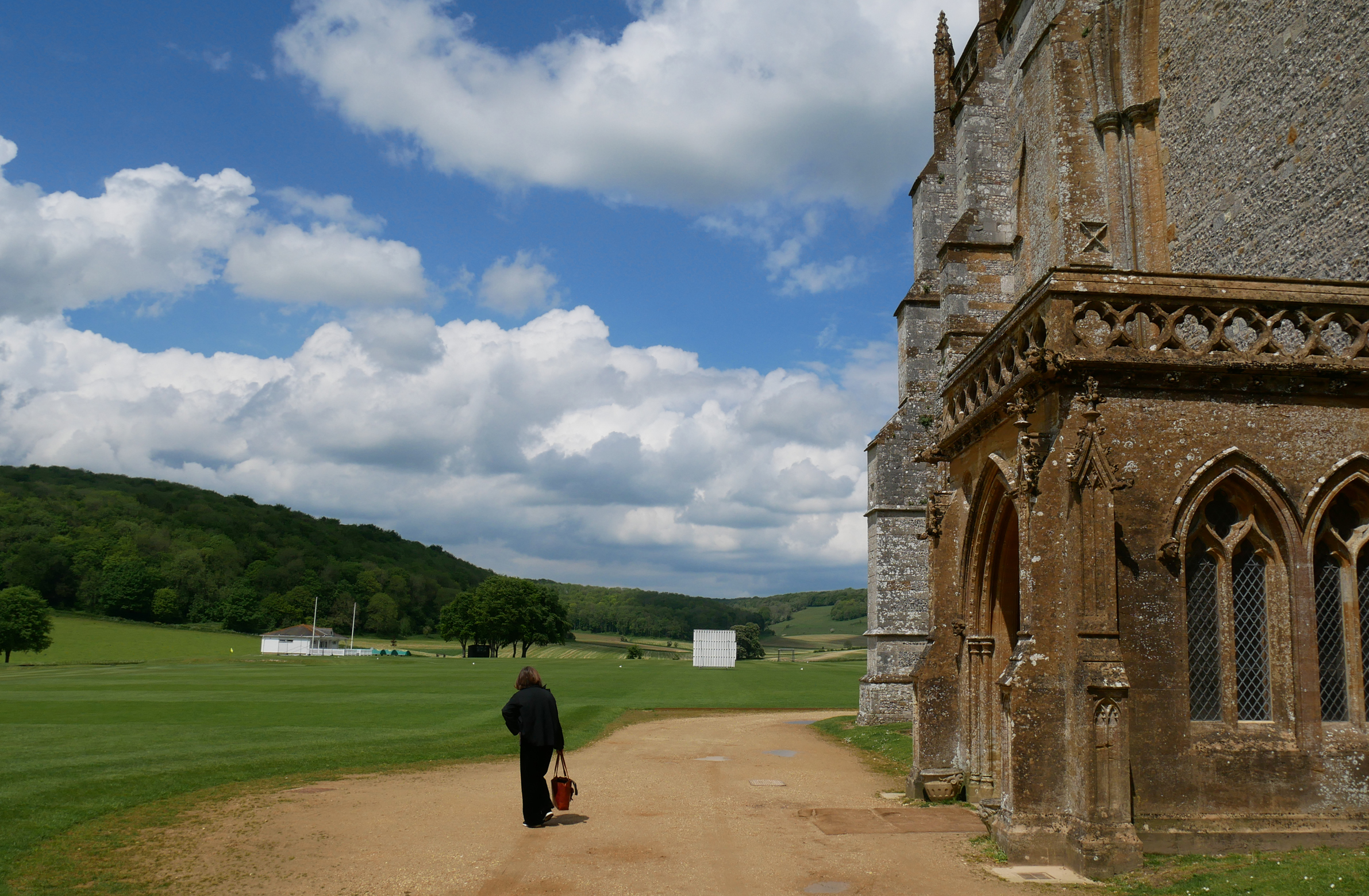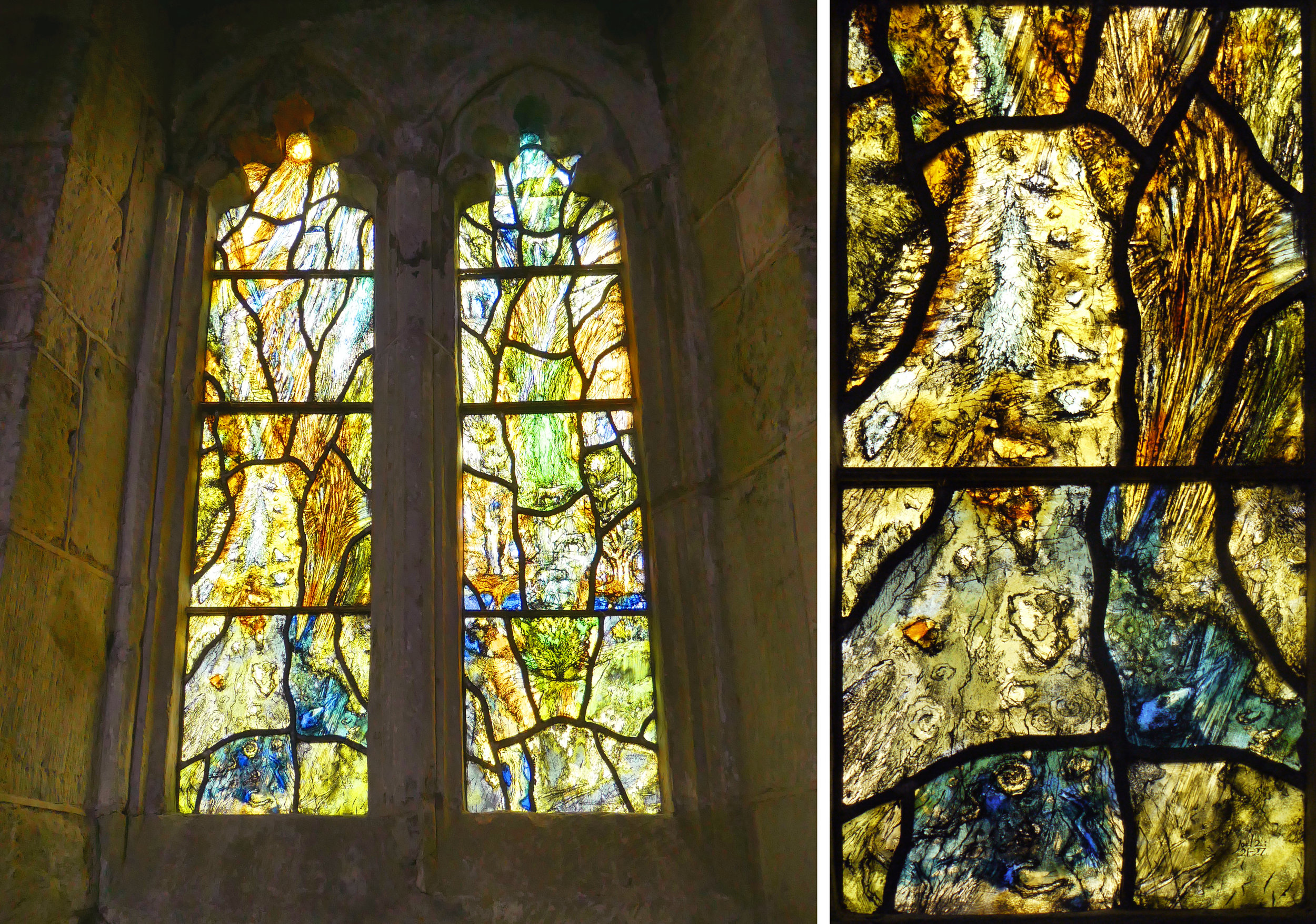On a beautiful day in Dorset, here I am in front of a cricket pitch on my way into Milton Abbey to appreciate some stained glass. Once inside, the abbey opens into a magnificent tall transept. On the north side is a monument to the Damers underneath a heraldic window bordered by roses and on the south side a huge tree of Jesse window designed by AWN Pugin and made by Hardmans, in typically vivid colours.
Left, south transept window above monument to Joseph & Caroline Damer. Right, Tree of Jesse window by Pugin, 1847.
However, I was not in Milton Abbas for the abbey but rather to see a Lawrence Lee window in St James Church in the famous landscaped village street. I’ve never knowingly seen a Lee window, but he wrote a book “The Appreciation of Stained Glass” which was one in the series on the appreciation of the arts published by the Oxford University Press. That was in 1977, the year that I went to the Central School of Art to do my Foundation Course and to learn how to make stained glass properly - in preparation I read Lee’s book thoroughly. Re reading it now I can see where I picked up many of my stained glass dos and don’ts based on the study of church windows - in particular lots of don’ts and harsh opinions on celebrated twentieth century windows.
Left, in front of the 1970 Lee window (I usually need a chair for taking photos). Right, the top of the window
I particularly like his chapter on (glass) painting which is one of the few to show an example of his own work, a distinctive head of St. Columba. Just from those few images I would have recognised these figures anywhere, and I’ve concluded that it’s his figures I particularly like, when usually it’s the figures in a window that I hate. These, St Catherine and the Virgin Mary shown below, remind me of inky black and white book illustration of the same period. Here is a passage from the painting chapter that is good to bear in mind when on these church visiting trips :
“The argument will always go on between those who make and those who talk about what is made - and it is very useful to both parties that it should be so. I believe, however, that in the context of this Appreciation of the Arts Series we ought to instruct ourselves to look, filtering out as far as possible any purely mental questions about dates, styles, authenticities and so on (all that is fun afterwards), so that appreciation becomes an impulsion of our physical self toward’s the artists work. We must literally pick up from the very point at which the glass painter’s brush left the glass, seeing what he saw as he laid it aside for firing.”
Lawrence Lee details - left, St Catherine and right, The Virgin and child.
Tom Denny window, St Mary, Tarrant Hinton 2000
Our route home went through Tarrant Hinton, so we made a stop to see a Tom Denny window. I have seen so much of his work recently that it’s beginning to grow on me - the leading patterns so particular that you can spot one in a church even when driving past. The presence of this small window, on a Dorset landscape theme, is huge with an overall golden glow. Here are some wise words from Denny:
“Colour is the most immediate thing about glass; most of your problems are solved if the colour is right for the place. Although I don’t aim to make glass look as if it were made hundreds of years ago, a happy by-product of the way I work - etching, plating and staining - not only enriches the surface, but creates a visual fragility equivalent to old glass.” From an interview with Tom Denny in Contemporary Stained Glass Artists by Kate Baden Fuller, A & C Black 2006.
I forgot to take the outside of the Tarrant Hinton window, so I’ve shown one in Leicester (below) from inside and out. You can see the irregular look of the lead pattern, and also the way that he draws his figures (animals in the Dorset window) as if they are knitted in to the backgrounds. That part of his work hasn’t grown on me yet, perhaps it’s the hardest thing to do well.
One of two Tom Denny 2016 windows in Leicester Cathedral from the inside and the outside.





